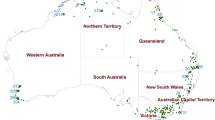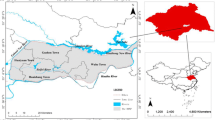Abstract
Proper regionalisation (identification of homogeneous regions) is key to reliable regional flood frequency analysis. Several methods have been proposed in the literature for regionalisation, including the method of residuals, L-moment method, and fuzzy c-means clustering algorithm. The present study explores the suitability of the theory of complex networks for regionalisation of watersheds, with an aim to perform regional flood frequency analysis. The west-flowing rivers of Kerala in India are considered for this study. Two complex networks-based methods, namely degree centrality and clustering coefficient, are applied for regionalisation, and daily streamflow data are analysed. To identify possible links between streamflow gauging stations, different correlation threshold values (i.e. linear correlations in streamflow between stations) are used. Two approaches are adopted in the use of correlation threshold values: the first (Method I) with threshold as mean, median, and mode of correlation values; and the second (Method II) with arbitrary threshold values. The regionalisation results suggest that Method II yields better results, both with degree centrality and clustering coefficient. Based on Method II, the use of degree centrality results in seven regions (five homogeneous and two heterogeneous) and clustering coefficient results in eight regions (seven homogeneous and one heterogeneous). Comparison of predicted and observed flood quantiles indicates that the degree centrality-based regionalisation yields R2 values in the range 0.94–0.86 for return periods 2, 5, 20, 50, and 100 years, whereas the clustering coefficient-based regionalisation yields R2 values in the range 0.98–0.91. The results from this present study suggest that complex network theory is a suitable alternative for identifying homogeneous regions for regional flood frequency analysis.











Similar content being viewed by others
Availability of data and material
The data used in this study were obtained from, and maintained by, the Central Water Commission (CWC), Government of India, and the Water Resources Department, Government of Kerala on certain conditions. The data may be obtained from the above agencies upon request.
Code availability
The code may be obtained from the authors upon request.
References
Albert R, Jeong H, Barabasi A-L (1999) Internet diameter of World Wide Web. Nature 401:398–399
Barabási A-L, Albert R (1999) Emergence of scaling in random networks. Science 286:509–512. https://doi.org/10.1126/science.286.5439.509
Basu B, Srinivas V (2014) Regional flood frequency analysis using kernel-based fuzzy clustering approach. Water Resour Res 50:3295–3316. https://doi.org/10.1002/2012WR012828
Bhaskar NR, O’Connor CA (1990) Comparison of method of residuals and cluster analysis for flood regionalization. J Water Resour Plan Manag 115:793–808
Boers N, Bookhagen B, Marwan N et al (2013) Complex networks identify spatial patterns of extreme rainfall events of the South American Monsoon System. Geophys Res Lett 40:4386–4392. https://doi.org/10.1002/grl.50681
Braga AC, Alves LGA, Costa LS, Ribeiro AA, de Jesus MMA, Tateishi AA, Ribeiro HV (2016) Characterization of river flow fluctuations via horizontal visibility graphs. Phys A 444:1003–1011
Burn DH (1990) Evaluation of regional flood frequency analysis with a region of influence approach. Water Resour Res 26:2257–2265. https://doi.org/10.1029/WR026i010p02257
Burn DH, Goel NK (2000) The formation of groups for regional flood frequency analysis. Hydrol Sci J 45:97–112. https://doi.org/10.1080/02626660009492308
Cavadias GS (1990) The canonical correlation approach to regional flood estimation. In: Regionalization in hydrology proceedings of the Ljubljana Symposium, April. IAHS Publ, pp 171–260
Cayley A (1857) On the theory of the analytical forms called trees. Philos Mag 13:172–176
CWRDM (1995) Water Atlas, Centre for Water Resources Development and Management. Kozhikode, Kerala. India
Cunnane C (1988) Methods and merits of regional flood frequency analysis. J Hydrol 100:269–290. https://doi.org/10.1016/0022-1694(88)90188-6
Dalrymple T (1960) Flood-frequency analyses. Man Hydrol 3 Flood flow Tech, Washington. https://doi.org/10.3133/wsp1543A
Davis KF, D’Odorico P, Laio F, Ridolfi L (2013) Global spatio-temporal patterns in human migration: a complex network perspective. PLoS ONE 8. https://doi.org/10.1371/journal.pone.0053723
de Arruda GF, Costa LDF, Rodrigues FA (2012) A complex networks approach for data clustering. Phys A Stat Mech Appl 391:6174–6183. https://doi.org/10.1016/j.physa.2012.07.007
Drissia TK, Jothiprakash V, Anitha AB (2019a) Statistical classification of streamflow based on flow variability in west flowing rivers of Kerala, India. Theoret Appl Climatol 137(3–4):1643–1658. https://doi.org/10.1007/s00704-018-2677-0
Drissia TK, Jothiprakash V, Anitha AB (2019b) Flood frequency analysis using L moments: a comparison between At-Site and Regional Approach. Water Resour Manag 33:1013–1037. doi:https://doi.org/10.1007/s11269-018-2162-7
Erdös P, Rényi A (1960) On the evolution of random graphs. Institute of Maths. Hungarian Acad Sci 5:17–61. https://doi.org/10.2307/1999405
Euler L (1741) Solutio problematis ad geometrian situs pertinentis. Comentarii academiae scientarum. Petropolitanae 8:128–140
Fang K, Sivakumar B, Woldemeskel FM (2017) Complex networks, community structure, and catchment classification in a large-scale river basin. J Hydrol 545:478–493. https://doi.org/10.1016/j.jhydrol.2016.11.056
Freeman LC (1978) Centrality in social networks conceptual clarification. Soc Netw 1:215–239. https://doi.org/10.1016/0378-8733(78)90021-7
Girvan M, Newman MEJ (2002) Community structure in social and biological networks. Proc Natl Acad Sci USA 99:7821–7826. https://doi.org/10.1073/pnas.122653799
Halverson MJ, Fleming SW (2015) Complex network theory, streamflow, and hydrometric monitoring system design. Hydrol Earth Syst Sci 19:3301–3318. https://doi.org/10.5194/hess-19-3301-2015
Han X, Ouarda TBM, Rahman A, Haddad K, Mehrotra R, Sharma A (2020) A network approach for delineating homogeneous regions in Regional Flood Frequency analysis. Water Resour Res 56(3):e2019WR025910
Hosking JRM, Wallis JR (1997) Regional frequency analysis: an approach based on L-moments. Cambridge University Press, New York
Hosking JRM (1990) Lmoments: analysis and estimation of distributions using linear combination of order statistics. J R Stat Soc 52:105–124
Jain AK, Murty MN, Flynn PJ (1999) Data clustering: a review. ACM Comput Surv 31:264–323
Jha SK, Zhao H, Woldemeskel FM, Sivakumar B (2015) Network theory and spatial rainfall connections: an interpretation. J Hydrol 527:13–19. https://doi.org/10.1016/j.jhydrol.2015.04.035
Jha SK, Sivakumar B (2017) Complex networks for rainfall modeling: spatial connections, temporal scale, and network size. J Hydrol 554:482–489. https://doi.org/10.1016/j.jhydrol.2017.09.030
Jothiprakash V, Drissia TK, Anitha AB (2021) Regional flood frequency analysis using fuzzy c-means clustering algorithm for west-flowing Rivers in Kerala, India. J Inst Eng (India): Ser A 102(3):805–813. https://doi.org/10.1007/s40030-021-00540-1
Kumar R, Chatterjee C (2005) Regional flood frequency analysis using L moments for North Brahmaputra Region of India. J Hydrol Eng 10:1–7
Listing JB (1848) Vorstudien zur Topologie, Vandenhoeck und Ruprecht, Göttingen, Germany, pp 811–875
Newman MEJ (2001) The structure of scientific collaboration networks. Appl Math 98:404–409
Naufan I, Sivakumar B, Woldemeskel FM et al (2018) Spatial connections in regional climate model rainfall outputs at different temporal scales: application of network theory. J Hydrol 556:1232–1243
Rao AR, Srinivas VV (2008) Regionalization of watersheds. Springer, New York
Rao AR, Hamed KH (1994) Frequency analysis of upper cauvery flood data by L-moments. Water Resour Manag 8:183–201. https://doi.org/10.1007/BF00877086
Rinaldo A, Banavar JR, Maritan A (2006) Trees, networks, and hydrology. Water Resour Res 42:1–19. https://doi.org/10.1029/2005WR004108
Rodríguez-Alarcón R and Lozano S (2019) A complex network analysis of Spanish river basins J Hydrol 578:124065
Saf B (2009) Regional flood frequency analysis using L-moments for the West Mediterranean region of Turkey. Water Resour Mana 23:531–551. doi:https://doi.org/10.1007/s11269-008-9287-z
Sarker S, Veremyev A, Boginski V, Singh A (2019) Critical nodes in river networks. Sci Rep 9:11178
Scarsoglio S, Laio F, Ridolfi L (2013) Climate dynamics: A network-based approach for the analysis of global precipitation. PLoS ONE 8:1–13
Serinaldi F, Kilsby CG (2016) Irreversibility and complex network behavior of stream flow fluctuations. Phys A Stat Mech its Appl 450:585–600. https://doi.org/10.1016/j.physa.2016.01.043
Shu C, Ouarda TBMJ (2007) Flood frequency analysis at ungauged sites using artificial neural networks in canonical correlation analysis physiographic space. Water Resourc Res 43:1–12. https://doi.org/10.1029/2006WR005142
Sivakumar B (2015) Networks: a generic theory for hydrology? Stochastic Environ Res Risk Assess 29:761–771. https://doi.org/10.1007/s00477-014-0902-7
Sivakumar B, Woldemeskel FM (2014) Complex networks for streamflow dynamics. Hydrol Earth Syst Sci 18:4565–4578. doi:https://doi.org/10.5194/hess-18-4565-2014
Sivakumar B, Woldemeskel FM (2015) A network-based analysis of spatial rainfall connections. Environ Model Softw 69:55–62. https://doi.org/10.1016/j.envsoft.2015.02.020
Srinivas VV, Tripathi S, Rao AR, Govindaraju RS (2008) Regional flood frequency analysis by combining self-organizing feature map and fuzzy clustering. J Hydrol 348:148–166. https://doi.org/10.1016/j.jhydrol.2007.09.046
Tiwari S, Jha SK, Sivakumar B (2019) Reconstruction of daily rainfall data using the concepts of networks: accounting for spatial connections in neighborhood selection. J Hydrol 579:124185
Tsonis, Roebber P (2004) The architecture of the climate network. Phys A 333:497–504
Tumiran SA, Sivakumar B (2021a) Catchment classification using community structure concept: application to two large regions. Stoch Environ Res Risk Assess 35:561–578. https://doi.org/10.1007/s00477-020-01936-4
Tumiran SA, Sivakumar B (2021b) Community structure concept for catchment classification: A modularity density-based edge betweenness (MDEB) method. Ecol Ind 124:107346
Ward JH (1963) Hierarchical grou** to optimize an objective function. J Am Stat Assoc 58:236–244
Watts DJ, Strogatz SH (1998) Collective dynamics of ‘small-world’ networks. Nature 393:440–442
Yasmin N, Sivakumar B (2018) Temporal streamflow analysis: Coupling nonlinear dynamics with complex networks. J Hydrol 564:59–67. https://doi.org/10.1016/j.jhydrol.2018.06.072
Yasmin N, Sivakumar B (2021) Study of temporal streamflow dynamics with complex networks: network construction and clustering. Stoch Environ Res Risk Assess 35:579–595. https://doi.org/10.1007/s00477-020-01931-9
Acknowledgements
The authors would like to thank the two reviewers and the Associate Editor for their constructive comments and useful suggestions on an earlier version of the manuscript.
Funding
No funding was received for conducting this study.
Author information
Authors and Affiliations
Corresponding author
Ethics declarations
Conflict of interests
The authors declare no conflict of interest/competing interests.
Additional information
Publisher’s Note
Springer Nature remains neutral with regard to jurisdictional claims in published maps and institutional affiliations.
Rights and permissions
About this article
Cite this article
Drissia, T.K., Jothiprakash, V. & Sivakumar, B. Regional flood frequency analysis using complex networks. Stoch Environ Res Risk Assess 36, 115–135 (2022). https://doi.org/10.1007/s00477-021-02074-1
Received:
Accepted:
Published:
Issue Date:
DOI: https://doi.org/10.1007/s00477-021-02074-1




